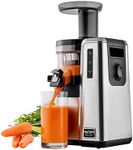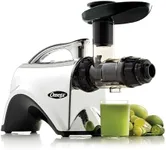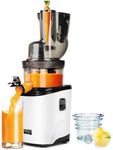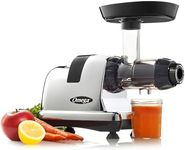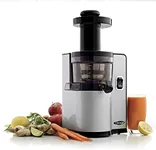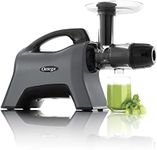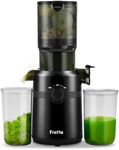Buying Guide for the Best Masticating Juicers
Choosing a masticating juicer can be a great decision if you want to make high-quality juice at home. These juicers work by slowly crushing and pressing fruits and vegetables to extract juice, which helps preserve nutrients and minimize oxidation. When picking the right masticating juicer, it's important to consider how often you'll use it, what types of produce you want to juice, and how much space you have in your kitchen. Understanding the key features will help you find a juicer that fits your lifestyle and juicing goals.Juicing Speed (RPM)Juicing speed, measured in revolutions per minute (RPM), tells you how fast the juicer's auger spins. Lower speeds (typically 40-80 RPM) are better for preserving nutrients and reducing heat buildup, which is ideal if you want the healthiest juice possible. Higher speeds (above 80 RPM) can process juice faster but may introduce more heat and oxidation, which can slightly reduce nutrient content. If you prioritize maximum nutrition and plan to juice leafy greens or wheatgrass, go for a lower RPM. If you want quicker results and mostly juice harder fruits and vegetables, a slightly higher RPM may be acceptable.
Feed Chute SizeThe feed chute is the opening where you insert fruits and vegetables. A larger feed chute allows you to put in bigger pieces or even whole produce, which saves time on prep work. Smaller chutes require more chopping and preparation. If you value convenience and want to spend less time cutting up ingredients, look for a juicer with a wide feed chute. If you don't mind prepping your produce or have limited counter space, a smaller chute may be fine.
Juice YieldJuice yield refers to how much juice you get from a given amount of produce. Higher yield means less waste and more juice for your money. Some juicers are better at extracting juice from leafy greens, while others excel with hard fruits and vegetables. If you want to maximize your juice output, especially from greens or wheatgrass, look for a juicer known for high yield in those areas. If you mostly juice fruits or root vegetables, most masticating juicers will perform well.
Ease of CleaningCleaning a juicer can be time-consuming, so it's important to consider how easy it is to take apart and wash the parts. Some models have fewer components and are dishwasher safe, while others require more manual cleaning. If you plan to juice frequently, choose a model that's easy to clean to avoid frustration and ensure you keep using it regularly. If you only juice occasionally, cleaning time may be less of a concern.
Size and WeightThe size and weight of a juicer affect how much space it takes up on your counter and how easy it is to move or store. Larger, heavier models may be more stable and have bigger motors, but they require more space. Compact models are easier to store and move but may have smaller capacities. If you have a small kitchen or plan to store the juicer between uses, look for a compact and lightweight option. If you have plenty of space and want a more robust machine, a larger model may suit you.
Noise LevelMasticating juicers are generally quieter than centrifugal juicers, but noise levels can still vary. If you plan to juice early in the morning or in a shared living space, a quieter model can be a big advantage. If noise isn't a concern for you, this may be less important.
VersatilitySome masticating juicers can do more than just juice—they can make nut butters, sorbets, baby food, or even pasta. If you want a multi-purpose appliance, look for a model with extra attachments or functions. If you only want to make juice, a simpler model may be all you need.





